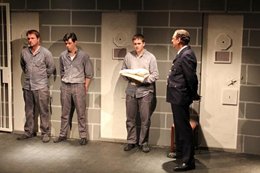In reviving Behan’s 1954 play, Ronan Wilmot asserts his sense of theatrical history (identifying warmly with the work of Caroline Swift and Alan Simpson in the Pike Theatre on the original production), and – in some of the best moments - a sensitivity for Behan’s capacity to write of the horrors of a hanging, both graphically and with a degree of lyricism.
But The Quare Fellow has not weathered well. Capital punishment has been erased from the statute books in Ireland and, for a long time, film has proved to be the medium most sympathetic to portraying grim prison life. Besides, gaol, as represented at the New Theatre, is a far cry from what we hear of today’s overcrowded hell-holes. It’s two men to a cell – long time since anyone in Mountjoy enjoyed that luxury - the place is generally quiet (birdsong in evidence), the tapping on the pipes is tentative. The young prisoners are harmless ‘pups’, making occasional shapes and panting after glimpses of the women inmates; the old lags (Michael Shanley and P.J. Brady) are caught in a time-warp, somewhere between Sean O’Casey, Jimmy O’Dea and Bill Cullen, harmless oul’ divils from the ‘rare oul’ times’; the only shock centres on the sex offender (“dirty beast”), while the murderers are respected.
With the exception of Regan - the ‘screw’ with a conscience, played with fine dignity by Luke Hayden in the most convincing performance of the evening – most of those in authority are pathetic parodies: the bullying Chief (Brian McGovern, totally hindered in the ‘suspension of disbelief’ stakes by having to wear an absurdly-oversized uniform), and the cartoon hangman (hard to tell if it’s Behan or Seamus Whelan making the ham-fisted caricature destroy any sense of menace as the execution time approaches).
 Visually and aurally, it’s underwhelming. Designer Peter McPoland, caught in a space between naturalism and tokenism, has tried to compress the prison into a tiny, intimate space. He has miniaturized the cells; when the lights come up, the walls fade from block-work to painted board; the bars are clearly flimsy dowelling. At the start Wilmot has Regan play out a prolonged ritual of unlocking; thereafter it seems to become an open prison, with a lot of casual coming and going.
Visually and aurally, it’s underwhelming. Designer Peter McPoland, caught in a space between naturalism and tokenism, has tried to compress the prison into a tiny, intimate space. He has miniaturized the cells; when the lights come up, the walls fade from block-work to painted board; the bars are clearly flimsy dowelling. At the start Wilmot has Regan play out a prolonged ritual of unlocking; thereafter it seems to become an open prison, with a lot of casual coming and going.
Wilmot just can’t seem to hold onto the atmosphere of the play. We get an off-stage ballad at the very start, followed by a pregnant pause, which builds expectation, only then to be shattered by the safety-exit announcement and a recorded lecture on the play’s history. Then – and only then – do we get 'The Auld Triangle', in a gravel-throated rendition from Jer O’Leary, one of the few vocal highlights. But even this is dissipated at the end when, after the climax of the execution - which is well conveyed by a crescendo of shouting and percussive hammer and chisel - the audience is encouraged into one final, sing-song run at 'The Auld Triangle'.
The pace has the evenness of a dirge, so that the gallows humour is muted and the death-row drama is leaden. The mood switches are too ponderous to be shocking. A few cast members display a lightness of touch – P.J. Brady, Conor O’Riordan, Fionn Ó Loingsigh – but it’s not enough to salvage the play. It will take more panache, higher production and acting values to “re-energise” (Wilmot’s words) Behan’s drama. On the basis of this showing, the jury is still out as to whether it can be done at all.
Derek West is the Arts & Education Officer of the National Association of Principals and Deputy Principals. He edits the Association’s publications and administers its arts scheme for schools, Creative Engagement.